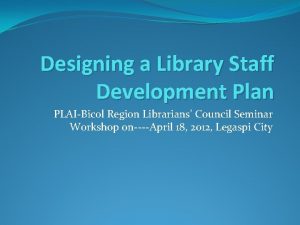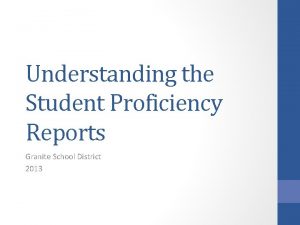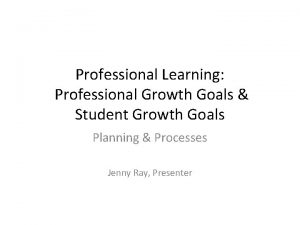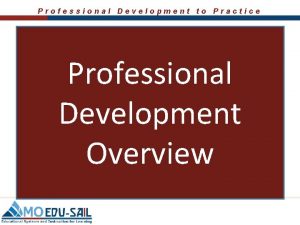Novice Teacher Professional Development Plan Classroom Learning Goals











- Slides: 11

Novice Teacher Professional Development Plan

Classroom Learning Goals

Purpose: Teachers will have the ability, skills and knowledge to set up classroom expectations, rules, and management. The Big Five Rules: Establish and Follow Through Routines: Build structure and establish routine within the classroom Praise: Reinforce positive behavior using praise and other means Misbehavior: Address misbehavior appropriately

Engaging the Student The following video will provide an in-depth approach to classroom management <iframe width="560" height="315" src="//www. youtube. com/embed/0 XUTda. QId. KI? rel=0" frameborder="0" allowfullscreen></iframe>

Positive Approaches to Classroom Management § Being a positive person contributes to the productivity of others. Students are more likely to be energetic, highly motivated, productive and alert when the classroom setting is positive. Educators should be looking for the good things in each student and realize nobody is perfect but everybody has many excellent qualities. One of the many approaches to motivating students is to relate to them and keep a positive attitude. In addition, the use of proper classroom management techniques would allow the teacher to instill individual learning styles and critical thinking skills by monitoring and adjusting to the students

Preventive Techniques of Classroom Management § Consider preventative methods of classroom management. Classroom management is not just about punishing students who behave poorly. It is also about practicing preventative measures that help you get control of a classroom before someone misbehaves. § Set the tone on the first day of class. Start building relationships with your students by being friendly and getting to know each other. Share the rules and consequences so they know up front how you expect them to behave. § Create a positive classroom environment. Encourage students to participate and acknowledge their contributions. Treat one another with respect. § Utilize a variety of teaching methods. Students learn in different ways. Use a mixture of lecture, small groups, activities, games, and multimedia. § Set your procedures and routines within the first two weeks. Review these when needed especially after Winter and Spring Break. Stick to a routine. This lets students know what to expect each day in class. While moving away from the routine periodically can be effective for special days, doing it often causes students to be unprepared.

Understanding A Classroom Management Plan • A classroom management plan is designed to help you get and maintain control of the classroom. It helps teachers know how to deal with unwanted behavior such as showing up late, a rude attitude, or incomplete assignments. By thinking these things through in advance, you will be better able to respond in these situations instead of responding in the heat of the moment.

Examples of a Classroom Management Plan 8

Examples of a Classroom Management Plan 9

Complete the Following Steps STEP 1: Write it down. For each of the following sections, write your answers. Be as specific and detailed as possible. Format it in a way that makes sense to you and that you'll have the easiest time in following it. STEP 2: Determine your philosophy. Many classroom management plans begin with the teacher's philosophy of motivation. • • Behaviorist theories of motivation are based on the ideas of psychologist B. F. Skinner. His theory revolves around the idea of reinforcement for behavior that you would like to be repeated and punishment for negative or unwanted behavior. Cognitive theories of motivation focus on beliefs and attitudes. In the classroom setting, teachers can manage the classroom by understanding what motivates students to do well, helping them identify their learning goals, interacting with students in a positive manner, and breaking down obstacles to learning. Humanistic theories of motivation are based on the teachings of Abraham Maslow. He believed that each person inherently wants to grow and reach the next level. His hierarchy of needs represents the different levels available for each person to achieve: physiological, safety and security, love and belonging, esteem, and self-actualization. Madeline Hunter's 6 variables of motivation approach are also a good source to follow: concern, feeling tone, success, interest, knowledge of results and extrinsic-intrinsic motivation. STEP 3: Incorporate school policies and procedures that are aligned to the Classroom Management Development Plan. Build off these and incorporate your own policies, procedures and rules to create a positive classroom environment for your students. 10

STEP 4: Incorporate school policies and procedures that are aligned to the Professional Development Plan. Build off these and incorporate your own policies, procedures and rules to create a positive classroom environment for your students. STEP 5: Define classroom rules. It is important that you follow these rules, too. Set the example for students and let them know they can trust you to keep your word. List these in your plan: • Focus on some themes or big ideas. For example, respect and integrity are common values in classroom settings. • Get specific. Big themes are helpful, but only if they are translated into specific behaviors. For example, respect can be demonstrated through showing up on time, not interrupting others, keeping cell phones and other electronic devices put away, and paying attention. • Create the rules together. At the very least, explain your rules and then discuss them with your class. This allows them to contribute and gives them some ownership of the class STEP 6: Explain consequences for breaking those rules. Communicate consequences up front so students know what to expect when they behave inappropriately. These can be explained the first day of class, put on a poster in the classroom, or included in the course syllabus. Be as specific as possible. Then be sure to follow through. STEP 7: Write a contract explaining your rules, consequences, rewards, procedures and expectations to the students and the parents. Have the student sign and return the contract. 11
 Learning and development plan for teachers
Learning and development plan for teachers Teacher professional development plan template texas
Teacher professional development plan template texas Strategic goals tactical goals operational goals
Strategic goals tactical goals operational goals Strategic goals tactical goals operational goals
Strategic goals tactical goals operational goals T-tess professional goals examples for teachers 2020
T-tess professional goals examples for teachers 2020 Community linkages and professional engagement competencies
Community linkages and professional engagement competencies Kenya professional teaching standards
Kenya professional teaching standards Library staff development plan sample
Library staff development plan sample Sourima mal
Sourima mal General goals and specific goals
General goals and specific goals Examples of generic goals and product-specific goals
Examples of generic goals and product-specific goals Novice intermediate advanced
Novice intermediate advanced





















